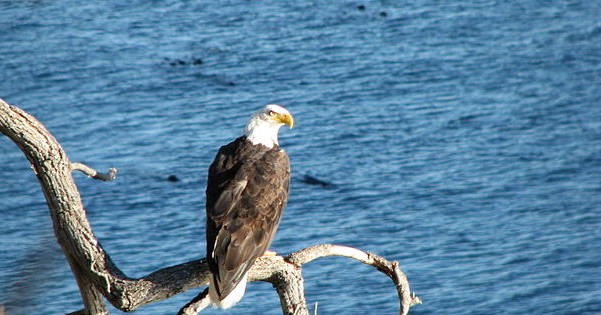
The bald eagle (Haliaeetus leucocephalus) is a big, powerful raptor—bird of prey. It has a white-feathered (not bald) head, brown body, yellow talons, a big hooked yellow beak, and a wingspan of six to eight feet. Its peals, chips, and chortles are high and small, as if the bald eagle’s inner bird were a sparrow.
If you drive north from Seattle, where I live, to the Skagit Valley, you find yourself among the fields and farms that lie between snow-topped Cascade Range and the fjord that is Puget Sound. It’s a valley of dairy cows and barns, tulip farms, farmers’ markets, blueberries, horses, and alpacas, and it’s a valley of birds, lots of them, including the bald eagle. Look up. They’re specks in the sky, soaring on convection currents, their enormous wings motionless. In December and January they’re especially numerous, having migrated south from Alaska and British Columbia to feed on salmon carcasses on the Skagit River after the salmon run has spawned and died.
The eagle is an emblem of spirit to Indian tribes, and the bald eagle’s likeness is displayed on quarters and dollar bills as our national bird. Bald comes from piebald, a word meaning two-colored, especially including white.
They live in monogamous pairs for life, a span that runs for 20 or 30 years in the wild. If a bird loses a mate, come breeding season he or she will seek a new partner. They court by performing aerial dives and displays designed, it seems, to make human air-show pilots feel inadequate. They construct the mother of all bird nests at the tops of massive trees, mostly with sticks. They remodel and add on each year, and a nest can reach nine feet across and weigh half a ton. They lay one to three eggs a year, incubating them for a bit over a month. Eagle chicks are all brown. The parents feed them (fish is the preferred food) and guard them. They fly at about the age of 12 weeks but don’t fly away. They stick around with their parents.
We almost lost the bald eagle, and the fact that the species has come back and is now thriving is one of our great environmental achievements. In the mid 20th century the birds got a bad rap and were alleged to eat toddlers (false) and baby lambs (mostly false—they do eat mice and small mammals). People detested them and would shoot them for the hell of it. Habitat loss was egregious—eagles need those huge high trees on riverbanks and on the shores of bays. But worst of all, during our national DDT craze that began after World War II and ran until DDT was banned for most uses in the United States in 1972, the bald eagle, consuming DDT-poisoned salmon, ceased being able to reproduce properly. It laid thin-shelled eggs that broke during incubation or would fail to hatch. [See “Ode to (Silent) Spring,” a Science Frictions essay about Rachel Carson, posted last month.]
In 1963, according to the United States Fish and Wildlife Service, there were 487 nesting pairs remaining in the lower 48 states. (The situation farther north, in Alaska, was better.)
The road back included the DDT ban, various protections under the Endangered Species Preservation Act (1966) and the Endangered Species Act (1973), and efforts toward habitat restoration and preservation. The bald eagle was delisted as threatened or endangered in 2007. There are now nearly 10,000 nesting pairs in the lower United States, and in Alaska they have remained abundant.
They are up there again, soaring. A beautiful thing.

